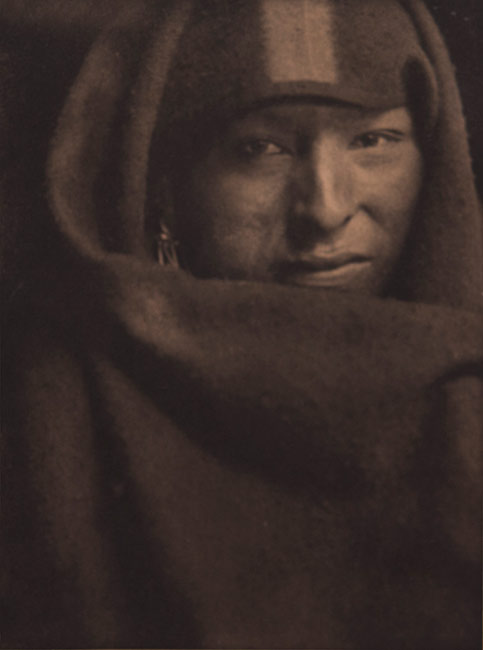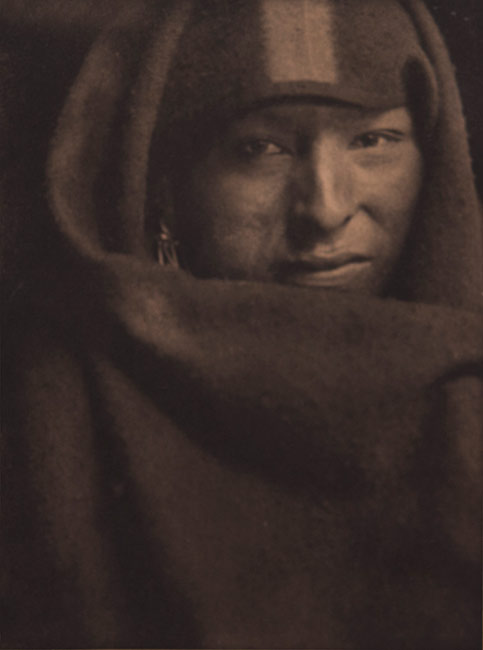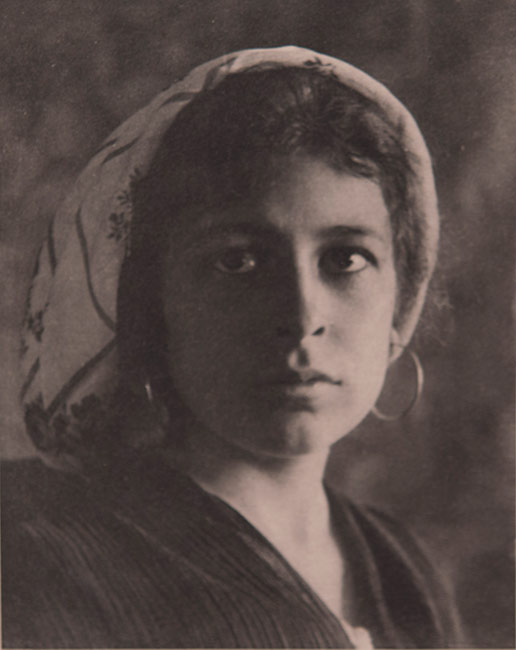Today I would like to consider two photographs by American photographers, The Red Man by Gertrude Käsebier and Ziletta by F. Holland Day. The two images are remarkably similar, presenting close-up, cropped depictions of the human face. Both photos, reproduced in these versions using photogravure, were originally done as platinum prints, a process which allows the production of warm tonal ranges.1 In fact, these two photographs date from a key moment in the history of photography, one in which the medium was not yet considered art. For the first sixty-odd years of the medium’s existence, in fact, it was widely agreed that it was not appropriate for art. Photography’s indexicality, its ability to completely and minutely capture visual reality, relegated it to the status of scientific or mechanical tool. It was artists like Käsebier and Day, good friends despite their very different life circumstances, who made photography’s shift in status to that of an artistic medium possible. They did so as part of the trans-Atlantic movement known as Pictorialism.2
Purchased with the Michel Roux Acquisitions Fund, 2013.13
Right / F. Holland Day (American, 1864–1933) Ziletta, 1895, Photogravure print
Purchased with the Michel Roux Acquisitions Fund, 2013.12
Day, the only son of a wealthy merchant from Dedham, outside of Boston, Massachusetts, had his finger on the pulse of several late-nineteenth century art movements. He originally began experimenting with a camera while running Copeland & Day, the artistic publishing house he founded with a friend in 1893, inspired by William Morris’s Kelmscott Press.3 Käsebier, on the other hand, did not start her career until she was 45, having waited until her three children were old enough that she could take time to attend Brooklyn’s Pratt Institute, where she trained as a painter under Arthur Wesley Dow before turning her attention to photography. Dow and her other teachers were dismayed by this move, believing that photography was appropriate only for capturing the world as it was, rather than the creation of original works of art.4 This divide is key to the development of Pictorialism. Day, Käsebier, and their fellows—most of whom quickly became associated with the Photo-Secession, a group created by gallerist and photographer Alfred Stieglitz to promote photography as an art form—eschewed photography’s supposed scientific rationality in favor of personal subjectivity, often manipulating their negatives and prints in order to achieve painterly effects, in particular a rich, dark tonality inspired by the American expatriate artist James Whistler.5

(American, 1890–1976)
Telephone Poles, 1915
Photogravure print
Purchased with the Michel Roux Acquisitions Fund, 2013.27
Both photographers achieved widespread renown, winning awards on both sides of the Atlantic for these and other works. Despite this renown, however, both also fell out of favor among critics and historians, though recent scholarship has sought to revive both their reputations. This was due to a confluence of factors, including both personal conflicts and changing taste in photography. Day—whose interests were always idiosyncratic and whose wealth insulated him from the dictates of artistic fashion—and Käsebier—who maintained a thriving professional portrait practice that caused friction with the amateurism-obsessed Photo-Secession—both fell afoul of the mercurial Stieglitz, who set the tone for the development of photography as a modern medium.6 Though he had featured Käsebier in the first issue of Camera Work, his influential journal of modernist photography, Stieglitz cast her and Day out, featuring instead the work of the younger Paul Strand in the magazine’s last issue. Strand—who I hope to discuss more in a future post—was the foremost exemplar of “straight photography,” a movement which saw the act of artistic creation not in careful manipulation of the negative, but rather in the selection of the image to be captured. With his championing of Strand in Camera Work’s swan song, Stieglitz pealed the death knell of Pictorialism for generations. Käsebier and Day both had to wait until recent years for revivals in their artistic fortunes.7 Now, looking back, we can appreciate them not only for their historical importance, but also for their ability to capture something essential yet mysterious in the faces of their sitters.
1 Elizabeth Hutchinson, “When the ‘Sioux Chief’s Party Calls’: Käsebier’s Indian Portraits and the Gendering of the Artist’s Studio,” American Art 16, no. 2 (2002): 41. Kathleen A. Pyne and Georgia O’Keeffe, Modernism and the Feminine Voice: O’Keeffe and the Women of the Stieglitz Circle (Berkeley : Santa Fe : Atlanta: University of California Press ; Georgia O’Keeffe Museum ; High Museum of Art, 2007), 5.
2 Fred Holland Day and Pam Roberts, F. Holland Day (Zwolle: Waanders Publishers, 2000), 15–16. Michelle Anne Delaney, Buffalo Bill’s Wild West Warriors: A Photographic History by Gertrude Käsebier, 1st ed (Washington, D.C. : New York: Smithsonian National Museum of American History ; Collins, 2007), 7–9.
3 Day and Roberts, F. Holland Day, 14–15. Kristin Schwain, “F. Holland Day’s Seven Last Words and the Religious Roots of American Modernism,” American Art 19, no. 1 (March 2005): 35.
4 Delaney, Buffalo Bill’s Wild West Warriors, 7–9.
5 Gertrude Käsebier, Gertrude Käsebier: The Complexity of Light and Shade ; Photographs and Papers of Gertrude Käsebier in the University of Delaware Collections, ed. Stephen Petersen and Janis A. Tomlinson (Ausstellung, Newark, Del.: University of Delaware, University Museums, Old College Gallery, Mechanical Hall Gallery, Mineralogical Museum, 2013), 8.
6 Käsebier, 15–19. Day and Roberts, F. Holland Day, 11–12.
7 Käsebier, Gertrude Käsebier, 21.



